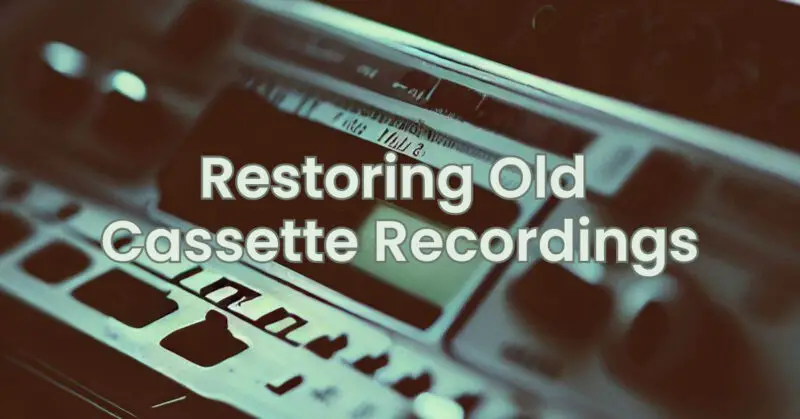Old cassette recordings hold a treasure trove of memories, capturing moments in time that are precious to us. However, as cassette tapes age, they can deteriorate, resulting in diminished sound quality, tape hiss, or even playback issues. Fortunately, with some care and the right techniques, you can restore and revive these vintage recordings, bringing back the nostalgia and preserving them for future generations. In this guide, we will explore the steps involved in restoring old cassette recordings, helping you uncover the magic hidden within these analog gems.
- Gather the Right Equipment: To restore old cassette recordings, you will need a few essential tools:
- A cassette player or deck: Ensure it is in good working condition with a clean playback head and functioning motor.
- Audio cables: Connect the cassette player’s line-out or headphone jack to your computer or audio interface.
- Computer or digital audio workstation (DAW): Use software to digitize and edit the recordings.
- Audio editing software: Choose a program that allows for noise reduction, equalization, and other audio restoration tools.
- Clean the Cassette Player: Before playing old cassette tapes, it’s essential to clean the cassette player. Dust, dirt, and debris can accumulate on the playback head, pinch rollers, and capstan, affecting sound quality. Use a soft, lint-free cloth or cotton swab slightly dampened with isopropyl alcohol to clean these components gently. Ensure they are completely dry before proceeding.
- Digitize the Recordings: Connect the cassette player to your computer or audio interface using the appropriate audio cables. Set the cassette player to play mode and start recording the audio into your chosen audio editing software or DAW. Monitor the recording levels to avoid clipping or distortion.
- Assess and Trim the Audio: Once you have digitized the recordings, listen to each track carefully. Identify any sections with excessive noise, clicks, or unwanted sounds. Use the audio editing software’s trimming and cutting tools to remove these imperfections, creating cleaner and smoother audio segments.
- Noise Reduction and Restoration: Old cassette tapes often suffer from tape hiss, background noise, or audio degradation. Use the noise reduction tools available in your audio editing software to reduce or eliminate these unwanted artifacts. Experiment with different settings and listen carefully to strike a balance between noise reduction and preserving the original audio quality.
- Equalization and Balancing: To enhance the overall sound quality of the recordings, use equalization tools to adjust the frequency response. This can help compensate for any imbalances or deficiencies in the original recording. Experiment with equalization settings to improve clarity, tonal balance, and overall fidelity.
- Track Sequencing and Metadata: If you are working with a collection of songs or recordings, arrange the tracks in the desired order. Add track markers or chapter divisions to make navigation easier for future playback. Additionally, consider adding metadata, such as track titles, album names, and artist information, to maintain a well-organized digital library.
- Create Backup Copies: Once you have restored and digitized your old cassette recordings, it’s crucial to create backup copies to safeguard against any future loss or deterioration. Store the digital files on multiple reliable storage devices, such as external hard drives, cloud storage, or archival-quality optical media.
- Preserve the Original Cassettes: While digitizing your old cassette recordings, it’s essential to preserve the original tapes. Store them in a cool, dry place away from direct sunlight and extreme temperatures. Consider using plastic storage cases or sleeves to protect them from dust, moisture, and physical damage.
Conclusion: Restoring old cassette recordings can be a rewarding journey, bringing back cherished memories and preserving them for years to come. By following the steps outlined in this guide, including cleaning the cassette player, digitizing the recordings, assessing and trimming the audio, applying noise reduction and restoration techniques, equalizing the sound, and creating backup copies, you can breathe new life into your vintage cassette collection. Enjoy the process of rediscovering the magic of analog sound and sharing the nostalgia with others while preserving these precious audio memories.


